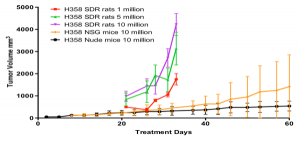Lung adenocarcinomas, the major histological subtype of non-small cell lung cancers (NSCLC), harbor oncogenic KRAS mutations in approximately 25% of cases. Many of the targeted therapies that have been studied and approved for the treatment of NSCLC specifically target the EGFR – KRAS – BRAF – MEK – ERK signaling kinase cascade as oncogenic addiction to these growth factor signals are commonly observed in NSCLC1. The earliest and most recently approved targeted therapies in NSCLC, including Pfizer’s VIZIMPRO® (dacomitinib), target EGFR. Oncogenic KRAS is a known anti-EGFR-drug-resistance mechanism.
The NSCLC cell line, H358 (AKA: NCI-H385, H-358), harbors a heterozygous missense KRAS mutation at codon 12 (G12C) which leads to constitutive activation of the EGFR-KRAS signaling cascade in H358 cells. Over 40% of KRAS mutant NSCLC have the G12C KRAS mutation found in H358 cells. KRAS has been demonstrated to be an oncogenic addiction in H358 cells as shRNA-mediated knockdown of KRAS expression inhibits cell proliferation in H358 cells. There are currently no drugs approved targeting KRAS mutant tumors and all attempts to target KRAS directly to this point have been unsuccessful.
Interestingly, H358 cells are highly sensitive to anti-EGFR therapies, despite having an oncogenic KRAS activation mutation. Additionally, H358 has no other major tumor suppressor or oncogenic mutations. This makes H358 an imperative NSCLC cell line model for trying to understand the complex relationship between KRAS mutations and drug resistance in NSCLC. Unfortunately, in vitro cell culture of H358 NSCLC cells is difficult and slow, which is why many researchers shy away from using them. Additionally, H358 cells have low successful xenograft rates in mice and xenografts that form grow slowly.
Conversely, Hera Biolabs has demonstrated that H358 cells form rapid, successful xenografts in humanized rats that are Rag2 knockout and deficient in B- and T- cells (SDR rats). These once culture-defiant, NSCLC cells form tumors with volumes between 2000-3000 mm3 within 25 days. This tumor growth was faster than growth rates reported in NSG and nude mouse models. See case study for methods details.

Figure 1: Enhanced survival of NSCLC cell line H358 and tumor kinetics in the SDR rat compared to Nude mice and SCID mice (NSG mice)
Drug development targeting KRAS in NSCLC and other cancers is a goal of the NCI and researchers alike. Improved in vivo xenograft models using H358 may be valuable for preclinical studies examining KRAS-targeting agents or drug combinations designed to overcome this oncogene addiction1.
References
- Hirsch, F. R.; Scagliotti, G. V.; Mulshine, J. L.; Kwon, R.; Curran, W. J.; Wu, Y.-L.; Paz-Ares, L., Lung cancer: current therapies and new targeted treatments. The Lancet 2017, 389 (10066), 299-311
